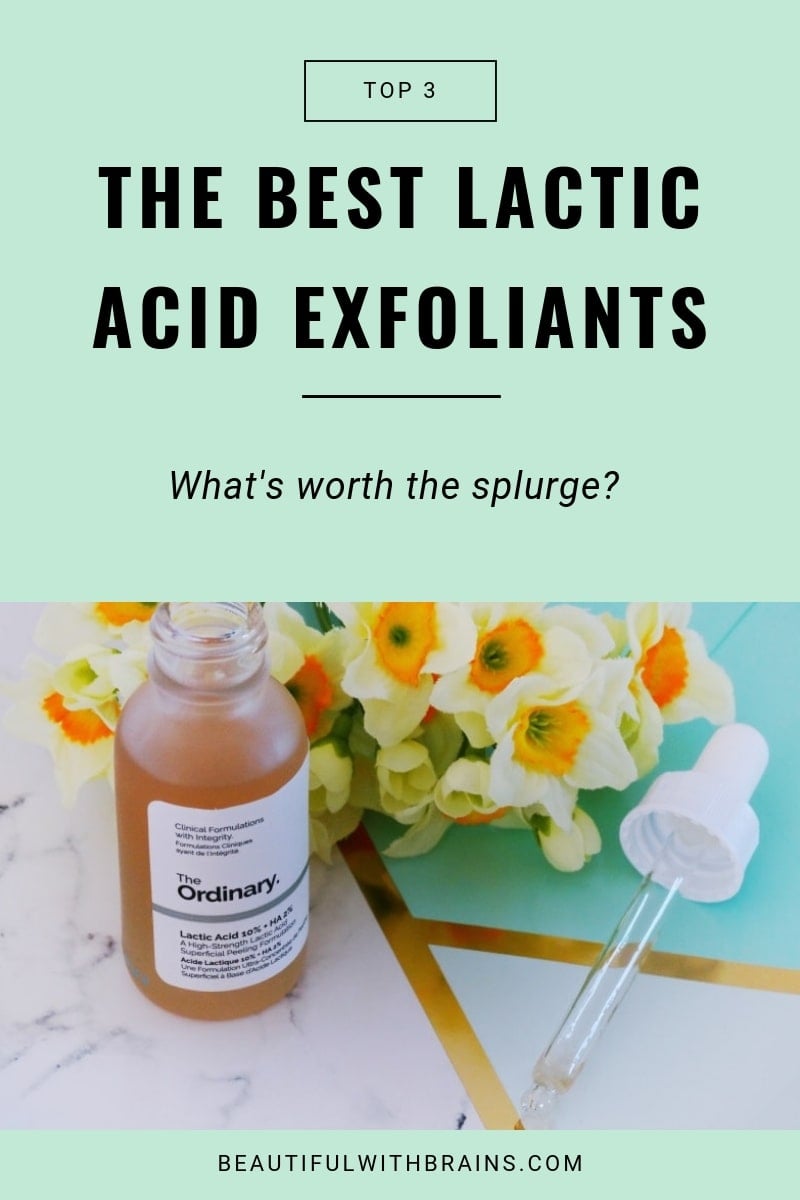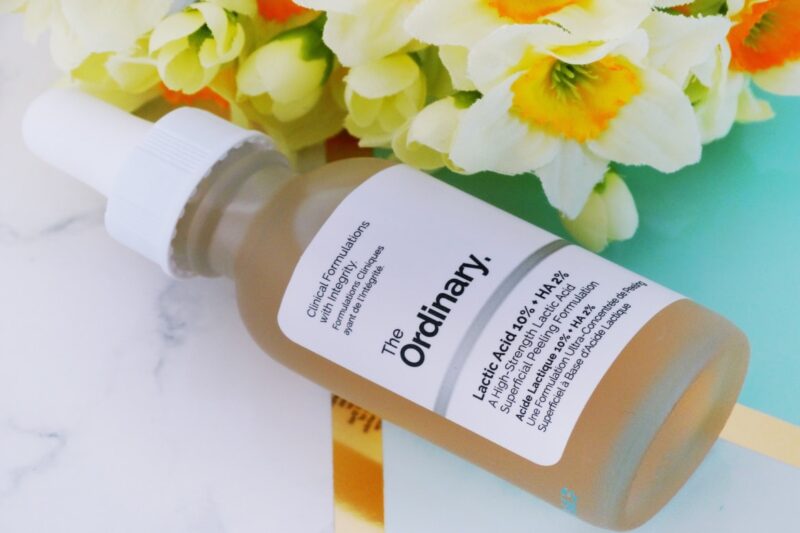
What are the best lactic acid exfoliants? Lactic acid is sort of the forgotten exfoliating acid. While everyone is obsessed with glycolic or salicylic acid for their abilities to fade away dark spots and treat acne, poor lactic acid is left on the sidelines. Like the player who never gets picked. Unless there’s an emergency.
In this case, sensitive skin. If glycolic or lactic acid irritate your skin too much and you’re wondering if you should bother with exfoliating acids at all, lactic acid comes to the rescue. This gentle acid is the safest way to exfoliate sensitive skin and get smoother and brighter skin without the peeling and irritation. The only question is, which product should you use? Here are the best lactic acid exfoliants for sensitive skin:
Lactic Acid Benefits
Lactic acid is the gentlest member of the exfoliating Alpha Hydroxy Acid (AHA) family. It’s the same family Glycolic and Mandelic Acids belong too. Like all AHAs, it works by dissolving the “glue” that holds skin cells together. When the top layer of damaged skin cells sloughs off, skin is softer. Smoother. Brighter.
“Lactic acid is seen by many as the gentler, more tolerated alternative to glycolic acid due to its slightly bigger molecule size,” says Lisa Kordecki, head therapist at beauty skincare provider SkinCity. Lactic acid is a big molecule, which means it doesn’t penetrate skin too well. Instead, it stays on the surface and does its job there. For an exfoliant, that’s enough to remove dead cells from the surface of your skin and brighten the complexion.
Lactic acid goes a step further. “Lactic acid has an extra benefit you won’t get from its AHA cousins,” adds Kordecki. “It’s a powerful humectant, helping improve the skin’s natural moisture barrier and hydration levels. This makes it ideal for dry or sensitive skin, alongside being a safe and effective ingredient for darker skin types, too.” Put even more simply, it exfoliates and hydrates skin at the same time.
The best part? Lactic acid is so gentle, even sensitive skin can use it. While other exfoliants often cause redness, peeling, and irritations in sensitive skin, lactic acid
What To Look For In Lactic Acid Exfoliants
Here’s what you need to look for when you’re shopping for a new lactic acid exfoliant:
- Concentration: If your skin is very sensitive or you’re new to acids, lactic acid may still cause mild irritation. To start with, pick a product with a very small dose, like 5%, and build your way to 10% from there.
- No other exfoliants: Lactic acid works more slowly alone than when combined with other acids, like Glycolic. If your skin is sensitive, go for it. Products with multiple acids will give you results faster. But, if your skin is sensitive, don’t be tempted with the promise of faster results. More acids means a higher chance of irritation. You won’t get results faster if you need to stop treatment cos your skin is all red and peeling.
- No fragrance or irritants: It’s incredible how many products that claim to be formulated for sensitive skin contain fragrance, essential oils, or other common irritants. As a rule, if it smells too good, it’s bad news for skin.
Is your sensitive skin throwing a tantrum every time you use something new? Download your FREE “Skincare Ingredients To Avoid” cheatsheet to find out what the most common culprits are and cut them out of your skincare routine:
FAQ ABOUT LACTIC ACID EXFOLIANTS
What can lactic acid exfoliants do?
Lactic acid exfoliants remove dead skin cells from the surface of your skin. They can brighten the skin tone, soften a rough complexion, make wrinkles look smaller, and even hydrate skin.
What can’t lactic acid exfoliants do?
They can’t treat acne. You need to get inside the pores for that and lactic acid can’t do it. Removing dead cells from the surface of your skin before they fall down into your pores and clog them can help prevent acne, but it won’t treat the acne you already have.
How often can you use a lactic acid exfoliant?
If you have sensitive skin, I recommend no more than twice a week. Too much exfoliation can can cause redness, dryness, and irritation.
When should you use a lactic acid exfoliant?
At night, right after cleansing. The closer to clean skin you apply it, the better it works. Plus, removing dead cells helps whatever you apply next better penetrate skin, so it can work faster.
Who should use a lactic acid exfoliant?
Anyone can use a lactic acid exfoliant, but they’re most suitable for sensitive skin that can’t tolerate more powerful acids.
What ingredients should you NOT use lactic acid with?
Do not use lactic acid on the same nights you use powerful actives as Vitamin C, retinoids, or glycolic acid. You’ll overwhelm your skin and risk irritating it.
What Are The Best Lactic Acid Exfoliants?
Here are the best lactic acid exfoliants even sensitive skin can tolerate:
The Ordinary Lactic Acid 5% + HA 2% ($6.79)
The Ordinary Lactic Acid 5% + HA 2% uses a very mild concentration of lactic acid to slough off dead cells. Plus, Tasmania pepperberry extract to soothe any potential irritation. Add hyaluronic acid, a moisture magnet that attracts water from the air into your skin, and you’ve got a clever little exfoliant that plumps up your skin, boosts its hydration and makes it glow. Seriously, if even this bothers your skin, stick to a washcloth.
P.S. The Ordinary Lactic Acid exfoliant is also available in a 10% concentration that gives you results faster. Start with 5% and work your way up slowly.
Available at: Beauty Bay, Cult Beauty, Look Fantastic, Sephora, SpaceNK, The Ordinary and Ulta
Active Ingredients: 5% Lactic Acid, hyaluronic acid, and Tasmania pepperberry.
Benefits: Exfoliates and brightens skin.
Cons: 5% is a very low concentration, so you’ll see results slowly.
Skin type: Very sensitive skin.
Fragrance-free: Yes.
Related: Why You Should Add Hyaluronic Acid To Your Skincare Routine

Sunday Riley Good Genes All-In-One Lactic Acid Treatment – US Version ($105.00)
Warning: In Europe, Sunday Riley Good Genes contains Glycolic Acid, Not Latic Acid. If you have sensitive skin and are in Europe, skip this product.
Do you need to spend $100+ to get your lactic acid fix? Nope. But if you’re into luxury skincare, Sunday Riley Good Genes is one of the few products that’s worth splurging on. It has enough lactic acid to do the exfoliating job easily, which alone is enough to give your skin a subtle glow. Plus, it has a sprinkle of licorice extract, a natural skin-brightener. If you have mild pigmentation, this is worth checking out. For severe hyperpigmentation, check out these other (more effective) options.
Available at: Sephora and Ulta
Active Ingredients: Lactic acid and licorice extract.
Benefits: Exfoliates, brightens and hydrates skin.
Cons: Expensive, there are cheaper options around that do the same thing.
Skin type: Sensitive skin.
Fragrance-free: Technically yes. But it has lemongrass oil that makes it smell good – and it can irritate sensitive skin.
Related: Lactic Acid Vs Glycolic Acid: Which One Is Right For You?
Peach & Lily Power Cocktail Lactic Acid Repair Serum ($51.00)
If you can afford the splurge, this is my fave lactic acid exfoliant on this list. Why? For starters, it has 10% lactic acid to exfoliate and brighten the complexion for smoother, younger-looking skin. Plus, it’s loaded with antioxidants and soothing ingredients that can help you fight premature aging and reduce redness. Sensitive skin can’t tolerate the most powerful anti-aging ingredients, like retinoids, so this is the next best thing. It keeps your skin young while you exfoliate it.
Available at: Peach & Lily and Ulta
Active Ingredients: 10% Lactic acid and antioxidants.
Benefits: Exfoliates, brightens and prevents wrinkles.
Cons: Packaging isn’t the most practical.
Skin type: Sensitive and mature skin.
Fragrance-free: Yes.
The Verdict
If you have sensitive skin and are struggling to find an acid exfoliant that doesn’t irritate your skin, you’re in luck. Here are the best lactic acid exfoliant for sensitive skin to brighten, smoothen, and hydrate your complexion without the irritation. Finally!


Dermalogica Gentle Cream Exfoliant is my favourite.
“Lactic and Hydroxy Acid exfoliating masque for dramatic skin smoothing. Non-abrasive exfoliation treatment helps stimulate cell renewal as natural fruit enzymes detach dead skin cells to improve skin texture.”
https://www.dermalogica.ca/on/demandware.store/Sites-dermalogica-ca-Site/en_CA/Product-Show?pid=9
Wwynter, I’ve checked the ingredient and there isn’t much lactic acid here. I think it’s the fruit enzymes that do the bulk of the exfoliating job. But glad it’s working so well for you. 🙂